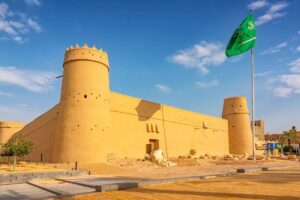
The ancient Masmak Fortress stands proudly in the center of Riyadh. Its majesty has not held back its magnificence. It has transformed into a tourist destination after having been a silent witness to momentous events in the history of the founding of the Kingdom of Saudi Arabia.
The palace was built in the fourteenth century AH, during the reign of Imam Abdullah bin Faisal, and served as his residence, as well as the seat of government and finance. The palace served as a fortified fortress protecting against enemies, distinguished by its strong and high walls. It has no windows, shutters, or openings, except for two entrances and small portholes that could accommodate the muzzles of guns during battles.
Today, the palace stands as a theatrical narrator of an authentic history of the restoration of power and the country. It recounts the landmarks of that period and the history of its leaders in its exhibition halls, after it was transformed into a museum in 1416 AH/1995 AD. The word “Masmak” or “Al-Masmak” means a thick, fortified building. One of the uses of this fort was as an ammunition and weapons depot, until it was decided to transform it into a historical landmark and then a museum.
The historic palace houses vivid images of the story of the unification of the Kingdom, including relics from the Battle of Riyadh, represented by the mark of Ibn Jalawi’s spear on the door of Masmak Fort. King Abdulaziz led his men in the battle in 1902, including Prince Fahd bin Jalawi. He threw his spear, intending to hit Ajlan bin Rashid, but it lodged in the door, creating a crack. The mark remains, a testament to the heroic story of one of the founding king’s most important aides.
The museum is divided into six main sections, containing its main contents: the palace gate on the western side, the mosque, the council hall (or diwaniya, as it is locally called), the well on the northeastern side, the towers distributed across the four corners of the courtyard, and the residential units that served as the residence of the ruler and his guests and were later converted into exhibition halls. You can walk through the entire history through visual displays inside the palace, and you will also see some ancient heritage pieces hanging on its walls.